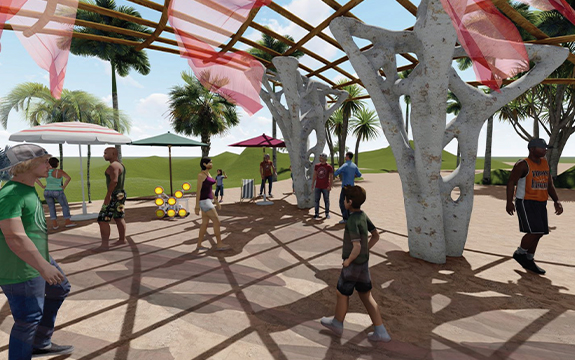Sustainable student pavilion design shortlisted in Wonderfruit competition

In Summary
- Swinburne students’ sustainable pavilion concept was a finalist in the Wonderfruit Festival competition
- Wonderfruit is Thailand’s pioneering art, music, food and ideas festival
- The pavilion design features mycelium tree-like structures and celebrates craft and engineering practice
A team of Swinburne students was one of seven finalists in a competition to design a sustainable pavilion, held as part of the Wonderfruit Festival in Thailand.
Wonderfruit is a pioneering art, music, food and ideas festival that aims to stimulate creativity and make a meaningful, positive impact. It runs off-grid for several days, like a pop-up sustainable city.
The festival issues an open call to organisers, designers and architects around the world, inviting creative teams to design a structure to showcase the Wonderfruit vision.
The Swinburne team included Bachelor of Design (Architecture) students Alexander Favorito and Nicole Farnell, as well as Stella Yang from RMIT. They created a pavilion made from mycelium - a mushroom root system - formed into strong, branched structures.
The students designed an early version of their mycelium pavilion, called Mycamode, at an Institute for Advanced Architecture of Catalonia (IAAC) Global Summer School hosted at Swinburne. They met and learnt about mycelium's properties and the use of Bi-directional Evolutionary Structural Optimisation (BESO) forms at the summer school, under the guidance of Swinburne Lecturer in Architectural Design, Canhui Chen.


 Mycamode’s tree-like mycelium structures and canopies by Alexander Favorito, Nicole Farnell and Stella Yang.
Mycamode’s tree-like mycelium structures and canopies by Alexander Favorito, Nicole Farnell and Stella Yang.
The Mycamode design for Wonderfruit details the use of reishi mushroom spawn from southern Thailand, combined with locally sourced organic waste (sawdust, corn, bamboo and straw). The mycelium mix grows, incubates and dries over four weeks in moulds that create branch-like mycelium components, joined together with bamboo to become tree-like forms. Mycamode is then returned to the earth once it is no longer in use.
“The competition was split into three submission phases and each one involved intensive, two-week long submission periods. The first deliverable was an animated postcard. We showed how BESO optimisation forms the Mycamode structure. The second was a booklet that explained how our structure was possible and how it could be built. Our final submission went into the smaller details of these aspects and how it would be incorporated into the WonderFruit Festival,” says Favorito.
“Mycelium forms a waterproof outer layer and when the material is dried out, it is very light and quite strong. Its thread-like 'branches' can withstand both compression and tension, and all of the material is organic and compostable. The use of BESO forms to produce this aspect of the structure reduces the amount of material required while maintaining strength,” Favorito explains.
 Rendering showing Mycamode’s tree-like structures and bamboo canopy, by Favorito, Farnell and Yang.
Rendering showing Mycamode’s tree-like structures and bamboo canopy, by Favorito, Farnell and Yang.
“The use of a mushroom root system seems to be a unique material concept. The idea of forming large tree-like structures, which festival-goers would be able to interact with, was something we were enthusiastic about,” he says.
An international jury of design experts chaired by Ab Rogers Design chose Mycamode as one of seven finalists from a shortlist of 23 entries. There were more than 100 submissions from around the world.
 Mycamode canopy detail, by Favorito, Farnell and Yang.
Mycamode canopy detail, by Favorito, Farnell and Yang.
Mycamode was chosen because it embodied the ethos and ethical values of the Wonderfruit Festival. It could last for at least five years with no environmental impact and is designed to evolve and adapt to changing tropical conditions, with a sustainable after-life.

